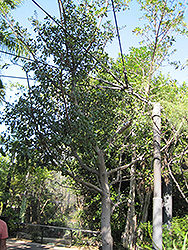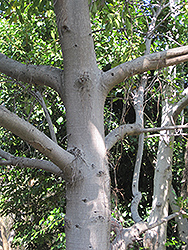It's all about ...
plants

Height: 50 feet
Spread: 50 feet
Sunlight:
![]()
![]()
Hardiness Zone: 10a
Other Names: Blunt Leaved Forest Fig, Bastard Natal Fig
Description:
A large, spreading, semi-deciduous tree with a dense, rounded, spreading crown; produces fruits that ripen from yellow to red, attracting birds; prune in late winter to maintain size and shape; aggressive roots, do not plant near walls or paving
Edible Qualities
Forest Strangler Fig is a large tree that is commonly grown for its edible qualities, although it does have ornamental merits as well. It produces yellow fruit (technically 'pomes') with a scarlet blush and gold flesh which are typically harvested when mature. The fruits have a sweet taste.
The fruit are most often used in the following ways:
- Fresh Eating
- Cooking
- Baking
- Preserves
- Drying
Features & Attributes
Forest Strangler Fig has attractive dark green foliage with grayish green undersides on a tree with an upright spreading habit of growth. The small glossy oval sprays of foliage are highly ornamental but do not develop any appreciable fall colour. The fruits are showy yellow pomes with a scarlet blush, which are carried in abundance from early summer to late fall. The fruit can be messy if allowed to drop on the lawn or walkways, and may require occasional clean-up. The smooth gray bark is extremely showy and adds significant winter interest.
This is a multi-stemmed deciduous tree with an upright spreading habit of growth. Its average texture blends into the landscape, but can be balanced by one or two finer or coarser trees or shrubs for an effective composition. This plant will require occasional maintenance and upkeep, and is best pruned in late winter once the threat of extreme cold has passed. It is a good choice for attracting birds to your yard, but is not particularly attractive to deer who tend to leave it alone in favor of tastier treats. Gardeners should be aware of the following characteristic(s) that may warrant special consideration;
- Messy
Aside from its primary use as an edible, Forest Strangler Fig is sutiable for the following landscape applications;
- Accent
- Shade
- Hedges/Screening
- Windbreaks and Shelterbelts
- Orchard/Edible Landscaping
Planting & Growing
Forest Strangler Fig will grow to be about 50 feet tall at maturity, with a spread of 50 feet. It has a low canopy with a typical clearance of 5 feet from the ground, and should not be planted underneath power lines. It grows at a fast rate, and under ideal conditions can be expected to live for 70 years or more.
This tree is quite ornamental as well as edible, and is as much at home in a landscape or flower garden as it is in a designated edibles garden. It does best in full sun to partial shade. It does best in average to evenly moist conditions, but will not tolerate standing water. This plant does not require much in the way of fertilizing once established. It is not particular as to soil type or pH. It is somewhat tolerant of urban pollution. Consider applying a thick mulch around the root zone in winter to protect it in exposed locations or colder microclimates. This species is not originally from North America.
This plant is not reliably hardy in our region, and certain restrictions may apply; contact the store for more information.

